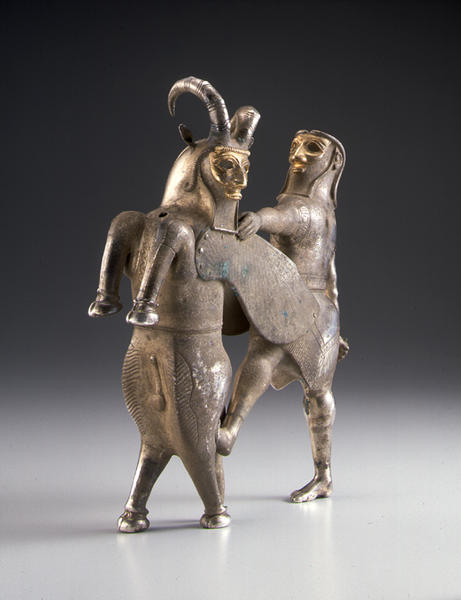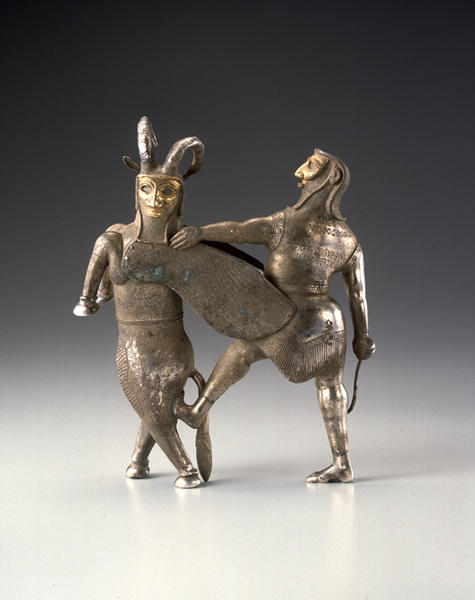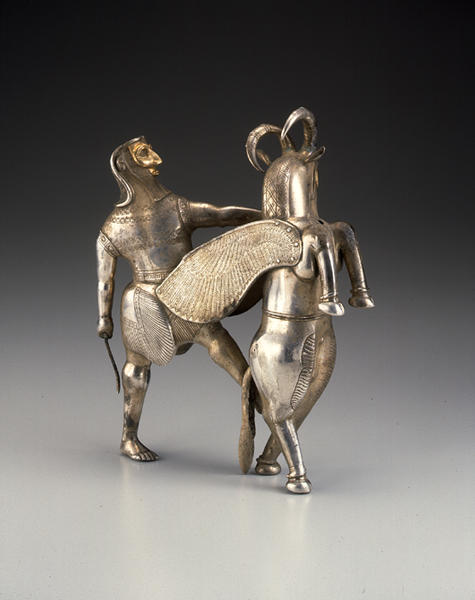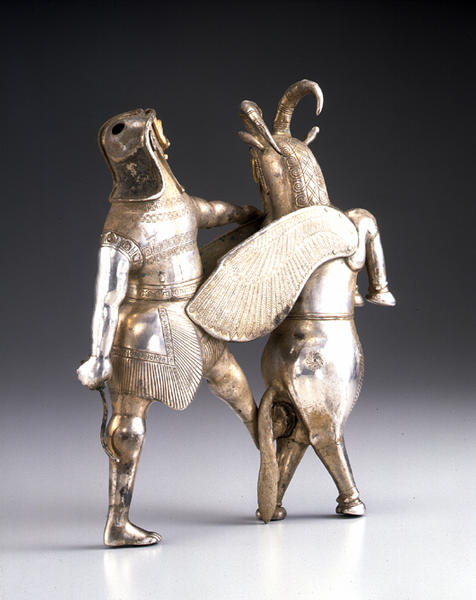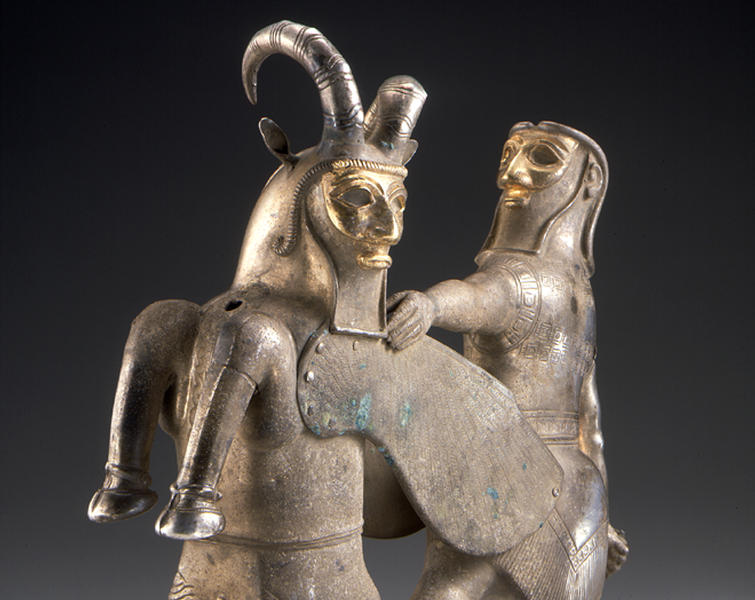英雄と有翼牡牛形容器
- 前アケメネス朝ペルシア
- 前8世紀-前6世紀
- 8-7cB.C.
- 銀、金
- H-27.5 W-22.2
解説(開館1周年記念展)
英雄は右手に刀を持ち左手で牡牛の左翼の付け根をつかみ,右足で地を踏ん張りながら左足で牛の左後脚の付け根を踏みつけている。衣装は短い膝上までの裾に長い房が巡り,前で合わせ後ろの中程が垂れている。中に小円を配した小さい方形の連続した装飾帯が,袖口,襟元,胸,腹部,裾に巡らされている。この種の衣装と文様の類例は前1千年紀初期の東アナトリアからメソポタミア,西イランに見られる。頭部は口と鼻から上の顔面に金を被せ,顔幅に比して大きめにあけられた眼窩は,その上に弧を描く眉なりに切られた溝とともに何らかの象嵌がなされていたことを窺わせる。もみあげから鼻,顎の周囲にかけての窪みは同様に別材で作られたひげが嵌め込まれていたのであろう。この顔面の造りはハサンルーから発掘された象牙細工にその近似例を見ることができる。*1 頭頂部には丸い穴があけられ,額の上から後頭部にかけて窪みがあり頭飾と頭髪をかたどった別材が嵌め込まれていたと思われる。額の上の縁枠が中央で分離して上に曲がった形態をしているが,これは冠が何らかの牛角の付いたものであったことを想像させる。
有翼の牡牛は人面であり,顔面およびひげの部分の造りは英雄と同様である。頭部の角は野生山羊のそれである。翼は杉綾文が施された剣形の羽根を三重に構成している。胸部の丸い穴の周囲には何物かを装着していた痕跡がある。一種の毛髪様の細い房が,額からこめかみ部を通って首の両脇に垂下しその両端が後方に巻き込む意匠は,東地中海地域,東アナトリア,北・西イランの,グリフィンや有翼あるいは無翼の半人半獣の霊獣表現と共通している。有翼の野生山羊表現はイラン高地で広く行われた意匠であるが,人面の有翼野生山羊表現が,前10世紀から前9世紀の西イラン・ルリスタンの意匠に存在し,後のアケメネス朝ペルシアでは野生山羊角で人面有翼の牡牛が表現された。*2
この英雄が右手に刀を持ち,左手で後ろ向きの獣や霊獣を捕らえ,左足で踏みつけている闘争図は前1千年紀初期バビロニアの円筒印章にも見られる。*3 前2千年紀頃からカッシート期のバビロニア,アッシリア,西・北イランのハサンルーやマルリクをつなぐ交易路が存在したと言われているが,これらの地域の工芸意匠には共通点が多々見られ,*4 このバビロニアの闘争図が,本作品に見られるように当時の西イラン的な心象で表現された可能性が考えられる。
英雄の左足部分で2体はつながっており,英雄頭部および有翼牛の胸の穴と併せてこれは何らかの器として使用されたことが想像される。
1 O. W. Muscarella/The Catalogue of Ivories from Hasanlu, Iran/Philadelphia 1980 nos.125, 126
2 P. R. S. Moorey/Ancient Bronzes Ceramics and Seals/Los Angeles 1981 no.433; W. Lukonin, A. Iwanow/Persische Kunst/Bourenmouth 1996 no.23 〈Pusikin Museum No.543891〉; MIHO MUSEUM南館図録/1997 no.36
3 D. Collon/First Impressions/London 1987 nos.369, 370
4 P. Calmeyer/Middle Babylonian Art and Contemporary Iran/in 'Later Mesopotamia and Iran' ed. J. Curtis, London 1995
Catalogue Entry
The hero holds a sword in his right hand and grasps the left wing of the bull with his left hand, with his left foot pressing against the left rump of the bull, while his right foot is firmly planted into the ground. The rather short back side of his coat has long tufts around the hem of the tail. The coat is buttoned in front and hangs down to the knee in back. Decorative bands of design a chain of small squares with circles inside encircle the cuff, collar, chest, waist, and hem of the coat. Similar types of clothing and decoration are also found in Eastern Anatolia, Mesopotamia, and Western Iran in the beginning of the 1st millennium B.C. The man's face, or more precisely, his mouth and portions above it, is covered with gold. That the eye-sockets are disproportionately large for the size of the man's face suggests that some type of inlay work was present originally, judging from grooves incised along the eyebrows arcing over the eye-sockets. The long depression on the face from the temple to below the nose and reaching the chin also raises a possibility that it was once covered with a beard made of another material. The man's face resonates with those found on ivory carvings excavated in Hasanlu.*1 A hole at the top of the head and a wide channel cut from above the man's forehead to the back of the head probably signify that other materials were fitted in those areas for a head ornament and hair. The frame-like element on the forehead is separated in the center and appears to curve up, suggesting that bull's horns were attached to the crown the man wore.
The winged bull has a human face, fashioned similarly to the man's, including the beard. The horns on the bull's head are those of the caprid. The wings are composed of three layers of sword-shaped feathers with herringbone pattern. Around a circular hole in the chest, there appears a trace suggesting something once attached. The tufts on the forehead, covering the temple, tucking behind the ears, and allowing them to hang down from the sides, then curing ends behind are almost common feature of griffins, also winged or unwinged half-human, half-animal supernatural beasts of eastern Mediterranean area, Eastern Anatolia, and Northern and Western Iran. Designs involving the winged caprid are quite common in the Iranian highlands: the winged and human-faced divine animal with caprid's horns can be found in metal works of Luristan in Western Iran during 10th to 9th centuries B.C., and later, human-faced winged bull with caprid's horns can be found in Achaemenid art.*2
The contest scene of a hero a sword in his right hand, holding onto an animal or a supernatural beast from behind and with the left foot pressing down on the animal's body resemble those found on cylinder seals of Babylonia in the early 1st millennium B.C.*3 The existence of an active trade route connecting Kassite-Babylonia, Assyria, Hasanlu in Western Iran and Marlik of Northern Iran has been speculated, which corroborates clear similarities in art and craft designs in these areas.*4 Incorporating the appropriate Western Iranian imagery of the day, the aforementioned contest scene from Babylonia quite possibly provided a theme to the present work.
The two figures in this piece are connected at the left foot of the hero. A variety of evidence, including the hole in the hero's head and the hole in the chest of the winged bull, point to a possible use of this work as a vessel.
